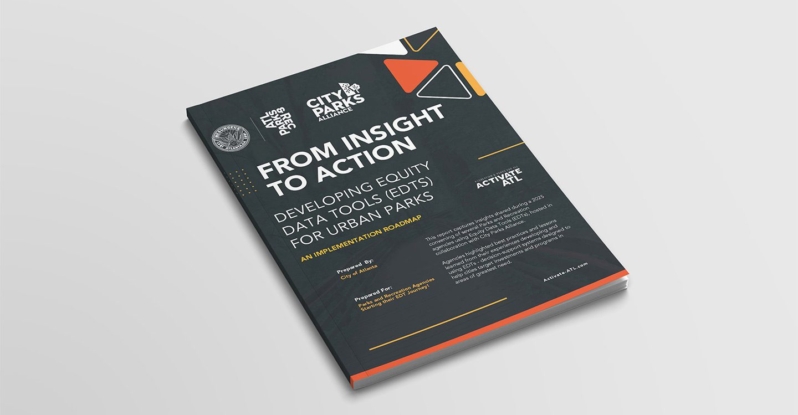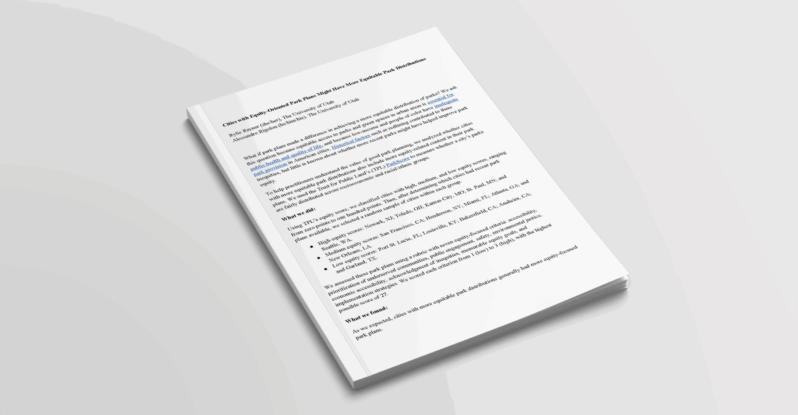Summary
Mayor Bill de Blasio was elected in 2013 on a platform to promote greater equity. In 2014, New York City released the Framework for an Equitable Future, which included the Community Parks Initiative, a multi-faceted program to invest in under-resourced public parks in the city’s densely populated and growing neighborhoods with higher-than-average concentrations of poverty. NYC Parks staff analyzed capital investment data from the past 20 years and worked to establish long-term community partnerships that generate stewards to sustain the ongoing care and investment in the city’s parkland.

Photo Credit: NYC Parks
New York, NY, June 2017: The newly refurbished Van Alst Playground in Astoria, Queens, was the first playground to be refurbished under the Community Parks Initiative. The project was funded with $3.5 million allocated by Mayor de Blasio through the Community Parks Initiative, and the playground reopened to the community.
Overview
NYC Parks is the steward of more than 30,000 acres of land — 14 percent of New York City — including more than 5,000 individual properties. The department operates more than 800 athletic fields and nearly 1,000 playgrounds, 1,800 basketball courts, 550 tennis courts, 65 public pools, 51 recreational facilities, 15 nature centers, 14 golf courses, and 14 miles of beaches. NYC Parks cares for 1,200 monuments and 23 historic house museums. NYC Parks looks after 600,000 street trees, and two million more in parks. NYC Parks is New York City’s principal providers of recreational and athletic facilities and programs, and home to free concerts, world-class sports events, and cultural festivals.
Framework for an Equitable Future
In October 2014, Mayor Bill de Blasio and NYC Parks Commissioner Mitchell J. Silver, FAICP, released the Framework for an Equitable Future, which outlined number of different initiatives. Central among these was the Community Parks Initiative—a multi-faceted program to invest in under-resourced public parks located in New York City’s densely populated and growing neighborhoods with higher-than-average concentrations of poverty. Through the Community Parks Initiative (CPI), New York City is investing $318 million capital dollars to reconstruct 67 parks and is bringing enhanced programming, maintenance, and community partnership building to neighborhoods most in need and improving park quality. This program is the first of its kind in New York City and will impact approximately 500,000 New Yorkers who live within a walk to these parks. Additionally, aligning efforts to make sites greener and more resilient, the NYC Department of Environmental Protection committed up to $50 million to build green infrastructure elements into CPI capital projects to capture storm water from surrounding streets.
Driving Force Behind the Initiative
One of Mayor de Blasio’s key objectives is equity, so NYC Park staff assessed city data to address equity issues within the parks system. Under Commissioner Silver’s direction, the Planning and Development division developed the Framework for an Equitable Future, which is featured in the city’s OneNYC strategic plan.
CPI is not simply a capital reconstruction program. In parallel with the capital reconstruction, NYC Parks has been investing in additional targeted maintenance resources and programming efforts at these sites. Through their outreach efforts, NYC Parks is working to support new community partners and stewards to help activate and care for these park sites. All of these efforts work in tandem to deliver a successful, long-term outcome for these parks to ensure that they do not fall through the cracks of capital disinvestment again.
Site Selection Criteria
The approach to building a program around equitable park investment began by first identifying traditionally under-resourced parks. NYC Parks analyzed capital investment data from the past 20 years and identified over 200 parks that had seen less than $250,000 of investment between 1992-2013. Next, NYC Parks assessed each park’s suitability for capital investment, performing on-the-ground surveys to identify parks with the most pressing need for physical improvement. Identifying need included taking note of structural issues but also required an eye for opportunity. For this particular program, NYC Parks sought out sites that offered an opportunity to re-imagine public spaces to provide diverse recreational opportunities and features for multiple age groups and abilities.
With over $1 billion in identified capital need, NYC Parks had to narrow its scope by prioritizing those sites that offered the greatest potential impact. In parallel to the site assessments, NYC Parks conducted a demographic analysis to screen for neighborhoods with high potential need. For this program, NYC Parks defined high-need communities as geographic areas with above average density, recent population growth, and above-average concentrations of residents living below the federal poverty line. NYC Parks focused the capital reconstruction projects in the parks that served these communities.
How to Keep the Program Running
Equity remains a central focus of the de Blasio administration and NYC Parks. CPI has made central the establishment of long-term community partnerships that generate stewards to sustain the ongoing care and investment in the city’s parkland. Connections between people, parks, and agency resources are facilitated to increase a community’s capacity to sustain parks as a key component of strong, healthy neighborhoods. Outreach coordinators, who are on the ground in communities across the city every day, organize community groups to build local stewardship and advocacy for parks. Outreach coordinators connect park stewards to NYC Parks and affiliated Partnership for Parks resources, including grants and trainings, to address community priorities and to create leadership capacity at the local level.
Tracking the Progress of the Initiative
NYC Parks has partnered with the CUNY School of Public Health to study the impact of CPI park reconstructions on community health metrics including physical activity, park usership, and social cohesion. The Physical Activity and Redesigned Community Spaces (PARCS) study is currently underway and is engaging thousands of New Yorkers over the next several years to measure CPI’s impact. NYC Parks and CUNY expect to release the results of that study in 2022.
Key Ingredients to Making Equitable Park Funding a Success
Showing clear, annunciated criteria that is grounded in sound and widely accepted data is a key ingredient for success. Further, it is imperative to facilitate equity through access to the development of a project. Through CPI, NYC Parks has improved its public input process to make public engagement in park redesigns more accessible. In improving the channel for public input into design, NYC Parks is building new parks that integrate diverse community needs.
Obstacles to Implementing Equity Park Funding
One of the challenges of implementing the Community Parks Initiative was delivering needed capital improvements while balancing day-to-day park access. Transformative capital projects require that parks be closed temporarily while improvements are underway. NYC Parks was careful to phase projects appropriately so that neighborhoods experiencing multiple capital improvements would not lack park amenities for an extended period of time. To help counter the impacts of construction related park closings in high need areas, NYC Parks dedicated in-house maintenance resources to extend the usable life of park features at nearby parks and playgrounds.
Can this Model be replicated?
Elements of the NYC Parks Framework for an Equitable Future could be adopted by other cities, particularly the demographic and land use components. NYC Parks has met with representatives from cities across the country and globe to speak about the Community Parks Initiative. While every city has its unique set of challenges and opportunities, NYC Parks is proud to serve as potential inspiration for pursuing park equity in other cities.
To reference this material, please cite Equitable Parks: Case Studies + Recommendations, City Parks Alliance, 2020.
Equitable Park Funding Research & Strategies
This case study is one of seven, compiled as part of City Parks Alliance’s national initiative to research, curate, and disseminate innovative strategies and models for funding parks and green infrastructure in low-income communities.



